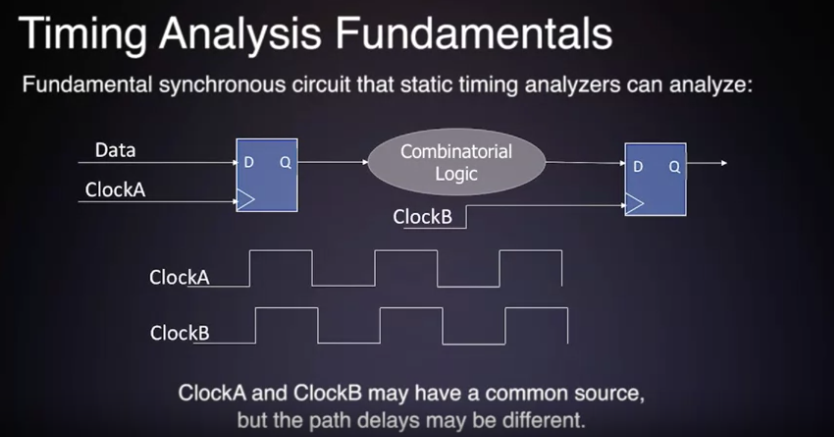-
Data must be stable before and after the clock edge to be reliably transferred. If not properly synchrnozed there could be hazards (unexpected or undesired
signals), metastability - a condition caused by timing vioaltions and flip-flop outputs leading to erroneous data, race conditions bugs that come and go,
clock skew
-
Static hazards occur as the consequence of unequal delays in logic. One way to remove the hazard is to add another gate. The best way is to use flip-flops
with synchronous design!
-

-
Clock A and Clock B may have the same source, but may have different delays.
-
Launch Edge = Clock Edge that activate sthe source register in a register-to-register path.
Latch Edge = Clock edge that activates the destination register and captures the data. Together they form a data requirement window.
-
Data Arrival Time = the time for data to arrive at a destination register's D input from the common clock edge.
Data (Setup) Arrival Time = Launch Edge + TclkA + Tco + Tdata
-
Clock Arrival Time = the time for clock to arrive at a destination register's clock input
-
Hold Time is defined as the minimum time the data signal must be stable after the clock edge
-
Data Required Time = the minimum time for the data to get latched into the destination register (AFTER the hold)
Data Required Time Hold = Clock Arrival Time + Th
Typical value is around 1 ns
-
Data Required Time (Setup) = the minimum time required for the data to get latched into the destination register (BEFORE the hold)
Data Required Time (Setup) = Clock Arrival time - Tsu (setup time usually specified in FPGA)
-
Setup slack = the margin by which the setup timing requirement is met
Setup Slack = Data Required Time (Setup) - Data Arrival Time
Setup Slack = Clock Period + TclkB - Tsu - TclkA - Tco - Tdata
-
Hold Slack = The margin by which the hold timing requirement is met
Hold Slack = Data Arrival Time - Data Required Time (Hold)
Hold Slack = TclkA + Tco + Tdata - TclkB - Th
-
When all timing is met, time enclosure is occuring. This is often a main goal of an FPGA's design.
-
I/O timing analysis uses the same slack equations.
-
Need to understand these to undersatnd cause of violation. Example causes, data path too long, requirements too short (incorrect analysis), large clock
skew signifying a gated clock etc
-
How to use timing quest analysis
-
Generate Timing netlist
-
Enter SDC constaints (Create and/or read in SDC file), constrain directly in console
-
Update timing netlist
-
Generate timing reports
-
Save timing constraints
-
User MUST enter constraints for all paths to fully analyze design. Timing analysis only performs slack analysis on constrained signals.
Constraints guide the fitter to place & route design in order to meet timing requirements. Prof recommends constraining all paths! (or at least clocks & I/O)
